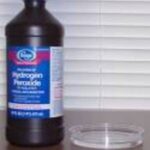When it comes to Hydrogen Peroxide as a medical therapy, there are many points of view. You’re either for or against it or maybe you’re unsure like me. I can tell you one thing, the arguments from both sides are very compelling. Enough so that to this day, I’m still unsure of what I think of the doctors who claim they are successfully treating cancer patients with hydrogen peroxide.
The chemical formula for hydrogen peroxide is H202. It has no odor and no color, however, will leave a taste in your mouth if gargled. The use of this product dates back to the 1920’s and there’s certainly no denying some of it’s uses. It’s a killer of bacteria and viruses and many parents have been known to apply this product to a cut or scrape on their child to prevent infection. It helps clear ear wax. My daughter had a problem with this and her pediatrician recommended diluted drops to keep her ears clear. It worked great. But, what about the hydrogen peroxide therapy being used to treat diseases such as cancer and aids? How safe is it? The answer: Depends on who you ask.
In an article by Dr. David G. Williams, he states, “hydrogen peroxide is one of the few simple miracle substances still available to the public.” Obviously, he’s for it. In this same article some of the conditions which are listed as being treatable by hydrogen peroxide include Type II Diabetes, Diabetic Gangrene, Emphysema, Cancer, Multiple Sclerosis, Alzheimer’s, and Herpes. The reasoning, according to Dr. Williams, is simple. We are oxygen starved. Hydrogen peroxide increases oxygen levels in our bodies. These diseases can’t survive in an oxygen rich environment. Several grades of hydrogen peroxide exist, however, the only one suitable for ingestion is the 35% food grade which is used in the production of food. Suggested use consists of following a schedule of 21 days in which increasing drops of hydrogen peroxide are added to distilled water and consumed on an empty stomach.
In addition to diseases, there are many claims that hydrogen peroxide is helpful for some of the more minor conditions. In an article on snopes.com, hydrogen peroxide is said to be helpful in treating foot fungus, toothaches, colds, yeast infections, and boils. In a contradiction article below it by Barbara Mikkelson, it’s stated that there is no evidence that hydrogen peroxide is effective for treating these conditions. She also states that using hydrogen peroxide to treat diseases such as cancer and aids amounts to “quackery.” This makes sense when you read that the American Cancer Society’s claims that using hydrogen peroxide to treat cancer is dangerous. Can we trust what the American Cancer Society says? I would’ve said yes until I read what they had to say about nicotine replacement therapy. Could they be getting money from the people who produce NRT? I would say yes. Just as they could be getting money from the people who sell cancer drugs.
The FDA is definitely on the “against” side. Their warning states that high strength hydrogen peroxide products can cause serious harm or death when ingested, according to an article by Dr. Simeon Margolis. He also addresses his concerns over the number of high-strength hydrogen peroxide products being sold over the internet. He says at first he believed people wouldn’t be dumb enough to buy the products, but after enough bought it to prompt the FDA to issue warnings, he changed his mind.
And, so what does it mean? Is it safe or not? Will it cure or treat the diseases some are claiming it will? I don’t know. But, I do believe we will never know for sure. I believe the fight will continue. The reason: Hydrogen peroxide is extremely cheap. Anyone, and I mean anyone can afford it. Even if it is the “miracle” many with these horrible diseases have been waiting for, they’ll never know it because no one will make money off it. Unfortunately, that’s more important to some in this country.


